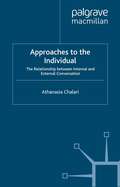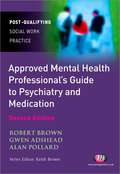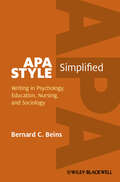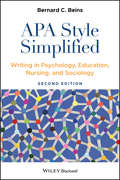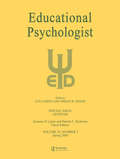- Table View
- List View
Approaches to the Development of Moral Reasoning (Essays in Developmental Psychology)
by Peter E. LangfordThe first part of the book offers a survey of current approaches to the development of moral reasoning: those of Freud, ego psychology, Piaget and Kohlberg. The approach of Kohlberg has been popular because he was able to give an impressive account of findings from the key method of interviews, the other crucial method being naturalistic observation of moral discourse. The accounts of interview evidence given by ego psychology and Piaget were less comprehensive and less impressive. Naturalistic studies have either been impressionistic or less detailed in their methods of analysis.The second part of the book argues that the impressive nature of Kohlberg's later evidence for his view that moral reasoning passes through a sequence of stages is in part illusory, because his theory predicts that specific types of reply will show specific developmental patterns. However, as data are always reported in terms of stages, which amalgamate very disparate types of reply, it is impossible to know whether the specific types of reply follow their predicted developmental courses or not. Reasons given for assigning given types of reply to a stage are also often doubtful. This leads to discussion of studies that have reported findings in terms of specific types of reply (weakly interpretive methods), as opposed to Kohlberg's stage-based and strongly interpretive methods. Findings from these disconfirm Kohlberg's theory at several crucial points.The second and third parts of the book also examine findings from non-Kohlbergian interviews and other methods, again advocating that weakly interpretive and largely descriptive presentation of findings is preferable to strongly interpretive techniques. It is argued that a wide variety of mechanisms suggested by the theories outlined in the first part of the book, as well as others drawn from general theories of personality development, are able to explain existing descriptive developmental findings. The task for the future is to assess the relative importance of these mechanisms.
Approaches to the Development of Moral Reasoning (Essays in Developmental Psychology)
by Peter E. LangfordThe first part of the book offers a survey of current approaches to the development of moral reasoning: those of Freud, ego psychology, Piaget and Kohlberg. The approach of Kohlberg has been popular because he was able to give an impressive account of findings from the key method of interviews, the other crucial method being naturalistic observation of moral discourse. The accounts of interview evidence given by ego psychology and Piaget were less comprehensive and less impressive. Naturalistic studies have either been impressionistic or less detailed in their methods of analysis.The second part of the book argues that the impressive nature of Kohlberg's later evidence for his view that moral reasoning passes through a sequence of stages is in part illusory, because his theory predicts that specific types of reply will show specific developmental patterns. However, as data are always reported in terms of stages, which amalgamate very disparate types of reply, it is impossible to know whether the specific types of reply follow their predicted developmental courses or not. Reasons given for assigning given types of reply to a stage are also often doubtful. This leads to discussion of studies that have reported findings in terms of specific types of reply (weakly interpretive methods), as opposed to Kohlberg's stage-based and strongly interpretive methods. Findings from these disconfirm Kohlberg's theory at several crucial points.The second and third parts of the book also examine findings from non-Kohlbergian interviews and other methods, again advocating that weakly interpretive and largely descriptive presentation of findings is preferable to strongly interpretive techniques. It is argued that a wide variety of mechanisms suggested by the theories outlined in the first part of the book, as well as others drawn from general theories of personality development, are able to explain existing descriptive developmental findings. The task for the future is to assess the relative importance of these mechanisms.
Approaches to the Individual: The Relationship between Internal and External Conversation
by A. ChalariThis study sees 'mediation' as a way of understanding the relationship between internal and external conversation, which underpins how individuals are connected to society. The relationship between these aspects of conversation is crucial in allowing selves to achieve subjectively-defined 'balance' between inner and outer worlds.
Approaches to the Study of Motor Control and Learning (ISSN #Volume 84)
by J. J. SummersDuring the past two decades, there has been a dramatic increasein interest in the study of motor control and learning. In thisvolume authors from a variety of backgrounds and theoreticalperspectives review their research with particular emphasis onthe methods and paradigms employed, and the future direction oftheir work. The book is divided into four main sections. Thefirst section contains chapters examining general issues andtrends in the movement behaviour field. The remaining threesections contain chapters from scientists working in threebroadly defined areas of interest: coordination and control;visuo-motor processes; and movement disorders. Each sectionprovides an overview of the different approaches and differentlevels of analysis being used to examine specific topics withinthe motor domain.
Approaching Consumer Culture
by Evgenia Krasteva-BlagoevaThis fascinating collection analyzes the impact of Western consumer culture on local cultures and consumption in Southeast Europe and East Asia. Cultural, historical, economic and sociopolitical contexts are examined regarding buying behaviors, usage and customization practices and consumer activism, specifically in Bulgaria, Serbia, and Romania as cultures continue to evolve in the post-socialist era, and in China and Japan as a continuation of movements toward modernity and progress. Surprising and thought-provoking contrasts stand out as consumers balance the global with the local in terms of clothing, technology, luxury items, and food. All chapters feature a wealth of empirical and cross-cultural data, and the presentation is framed by Professor Mike Featherstone’s theoretical essay on the origins of consumer culture and the consequences of two hundred years of increasing consumption for the human condition and the future of the planet.Included in the coverage:“You are a socialist child like me”: Goods and Identity in BulgariaConsumer Culture from Socialist Yugoslavia to Post-Socialist Serbia: Movements and MomentsPreserves Exiting Socialism: Authenticity, Anti-Standardization, and Middle-Class Consumption in Post-Socialist RomaniaModernization and the Department Store in Early 20th-Century Japan: Modern Girl and New Consumer Culture LifestylesA Cultural Reading of Conspicuous Consumption in ChinaApproaching Consumer Culture broadens the cultural anthropology literature and will be welcomed by Western and Eastern scholars and researchers alike. Its depth and accessibility make it useful to university courses in cultural anthropology, cultural studies, and sociology.
Approaching Multivariate Analysis, 2nd Edition: A Practical Introduction
by Pat Dugard John Todman Harry StainesThis fully updated new edition not only provides an introduction to a range of advanced statistical techniques that are used in psychology, but has been expanded to include new chapters describing methods and examples of particular interest to medical researchers. It takes a very practical approach, aimed at enabling readers to begin using the methods to tackle their own problems. This book provides a non-mathematical introduction to multivariate methods, with an emphasis on helping the reader gain an intuitive understanding of what each method is for, what it does and how it does it. The first chapter briefly reviews the main concepts of univariate and bivariate methods and provides an overview of the multivariate methods that will be discussed, bringing out the relationships among them, and summarising how to recognise what types of problem each of them may be appropriate for tackling. In the remaining chapters, introductions to the methods and important conceptual points are followed by the presentation of typical applications from psychology and medicine, using examples with fabricated data. Instructions on how to do the analyses and how to make sense of the results are fully illustrated with dialogue boxes and output tables from SPSS, as well as details of how to interpret and report the output, and extracts of SPSS syntax and code from relevant SAS procedures. This book gets students started, and prepares them to approach more comprehensive treatments with confidence. This makes it an ideal text for psychology students, medical students and students or academics in any discipline that uses multivariate methods.
Approaching Multivariate Analysis, 2nd Edition: A Practical Introduction
by Pat Dugard John Todman Harry StainesThis fully updated new edition not only provides an introduction to a range of advanced statistical techniques that are used in psychology, but has been expanded to include new chapters describing methods and examples of particular interest to medical researchers. It takes a very practical approach, aimed at enabling readers to begin using the methods to tackle their own problems. This book provides a non-mathematical introduction to multivariate methods, with an emphasis on helping the reader gain an intuitive understanding of what each method is for, what it does and how it does it. The first chapter briefly reviews the main concepts of univariate and bivariate methods and provides an overview of the multivariate methods that will be discussed, bringing out the relationships among them, and summarising how to recognise what types of problem each of them may be appropriate for tackling. In the remaining chapters, introductions to the methods and important conceptual points are followed by the presentation of typical applications from psychology and medicine, using examples with fabricated data. Instructions on how to do the analyses and how to make sense of the results are fully illustrated with dialogue boxes and output tables from SPSS, as well as details of how to interpret and report the output, and extracts of SPSS syntax and code from relevant SAS procedures. This book gets students started, and prepares them to approach more comprehensive treatments with confidence. This makes it an ideal text for psychology students, medical students and students or academics in any discipline that uses multivariate methods.
Approaching Psychoanalysis: An Introductory Course
by David Livingstone SmithThis book provides the scope and complexity of Freud's contributions and emphasizes the wide proliferation of the Lacanian approach. It describes psychoanalytical theories, and is helpful for the readers as a stimulus to independent investigation and critical thought.
Approaching Psychoanalysis: An Introductory Course
by David Livingstone SmithThis book provides the scope and complexity of Freud's contributions and emphasizes the wide proliferation of the Lacanian approach. It describes psychoanalytical theories, and is helpful for the readers as a stimulus to independent investigation and critical thought.
Approved Mental Health Practice: Essential Themes for Students and Practitioners
by Sarah Matthews Philip O'Hare Jill HemmingtonDrawing on a wealth of experience from both current and past practitioners in mental health, this book is a handbook for Approved Mental Health Practitioners at a time of uncertainty and change. The book considers the themes and issues relating to the role, the present day challenges and future directions for the profession.
Approved Mental Health Practice: Essential Themes for Students and Practitioners
by Sarah Matthews Philip O'Hare Jill HemmingtonDrawing on a wealth of experience from both current and past practitioners in mental health, this book is a handbook for Approved Mental Health Practitioners at a time of uncertainty and change. The book considers the themes and issues relating to the role, the present day challenges and future directions for the profession.
The Approved Mental Health Professional's Guide to Psychiatry and Medication
by Robert Brown Gwen Adshead Alan PollardThis book is essential reading for all Approved Mental Health Professionals (AMHPs) and those students and practitioners on mental health Post-Qualifying awards. It covers the core competencies of the AMHP and how the use of medication fits within the roles of the mental health professional. Fully updated to include aspects of the recently amended Mental Health Act 1983, this guide shows how the law is applied to compulsory administration of medication, the law relating to consent to treatment and the relevance to the European Convention on Human Rights.
Apps, Technology and Younger Learners: International evidence for teaching
by Natalia Kucirkova Garry FalloonThis book provides an in-depth analysis of the challenges, potential and theoretical possibilities of apps and considers the processes of change for education and home learning environments. Drawing together a diverse team of international contributors, it addresses the specific features, context of use and content of apps to uncover the importance of these tools for young children’s learning. Apps, Technology and Younger Learners focuses on ways that apps support early years and primary school learning, connect various learning spaces and engage children in a range of edutainment and knowledge-building activities. In each chapter, the current state of knowledge and key research questions in the field for future study are identified, with clear messages provided at the end of each chapter. Focusing on empirical studies and strong theoretical frameworks, this book covers four key parts: Understanding the learning potential of children’s apps; Key app challenges; Empirical evidence; Future avenues. This book is an essential guide for educators, post-graduate students, researchers and all those interested in the advantages or challenges that may result from integrating apps into early education.
Apps, Technology and Younger Learners: International evidence for teaching
by Natalia Kucirkova Garry FalloonThis book provides an in-depth analysis of the challenges, potential and theoretical possibilities of apps and considers the processes of change for education and home learning environments. Drawing together a diverse team of international contributors, it addresses the specific features, context of use and content of apps to uncover the importance of these tools for young children’s learning. Apps, Technology and Younger Learners focuses on ways that apps support early years and primary school learning, connect various learning spaces and engage children in a range of edutainment and knowledge-building activities. In each chapter, the current state of knowledge and key research questions in the field for future study are identified, with clear messages provided at the end of each chapter. Focusing on empirical studies and strong theoretical frameworks, this book covers four key parts: Understanding the learning potential of children’s apps; Key app challenges; Empirical evidence; Future avenues. This book is an essential guide for educators, post-graduate students, researchers and all those interested in the advantages or challenges that may result from integrating apps into early education.
Apraxia: The Neuropsychology of Action (Brain, Behaviour and Cognition)
by Kenneth M. Heilman Leslie J. Gonzalez RothiThe purpose of this book is to provide the reader with a perspective on apraxia that considers a link between the pathology of apraxia and normal motor skill. In addition, it is the intention of the authors to provide information that is theoretically interesting as well as clinically applicable. The book is a collection of papers by various authors working in the area of apraxia, almost exclusively with limb aparaxia specifically. Beginning with Hugo Liepman's work of the late 19th century, a cognitive neuropsychological model of limb apraxia is reviewed, the use of new technologies that are informative about the mechanisms of limb praxis are discussed, and issues related to research as well as clinical assessment/management of the disorder are provided. While acquired limb apraxia is the focus of the book, there are also chapters on handedness, developmental apraxia of speech, and disorders of handwriting.
Apraxia: The Neuropsychology of Action (Brain, Behaviour and Cognition)
by Leslie J. Gonzalez Rothi Kenneth M. HeilmanThe purpose of this book is to provide the reader with a perspective on apraxia that considers a link between the pathology of apraxia and normal motor skill. In addition, it is the intention of the authors to provide information that is theoretically interesting as well as clinically applicable. The book is a collection of papers by various authors working in the area of apraxia, almost exclusively with limb aparaxia specifically. Beginning with Hugo Liepman's work of the late 19th century, a cognitive neuropsychological model of limb apraxia is reviewed, the use of new technologies that are informative about the mechanisms of limb praxis are discussed, and issues related to research as well as clinical assessment/management of the disorder are provided. While acquired limb apraxia is the focus of the book, there are also chapters on handedness, developmental apraxia of speech, and disorders of handwriting.
Apraxia: The Neural Network Model (Neural Network Model: Applications and Implications)
by Theodore Wasserman Lori Drucker WassermanThe work will be a reanalysis and reconceptualization of the concept of apraxia. Apraxia is currently understood as a motor speech disorder but an analysis of the neural network properties of apraxia indicate a more complex and far reaching disorder with implications for intentionality, motor coordination and motor control of response inhibition in a variety of human behavioral and emotional reactions. A thorough redefinition of apraxia will be provided along with suggestions for diagnoses and treatment. The primary audience will be diagnostic and treating professionals in a variety of disciplines (outlined above). Secondarily, the book will provide an argument and justification for considering developmental apraxia pf speech to be a separate and discrete white matter based disorder. Finally, this work will serve as a driver of future research in the area.
Après-coup in Psychoanalysis: The Fulfilment of Desire and Thought
by Bernard ChervetThis important book argues that après-coup, a concept that has blossomed in French psychoanalytic discourse, not only allows an understanding of how repressed early memories determine adult life, and how human sexuality develops, but also allows for a richer and wider explanation of our mental structures and thinking. The book outlines how après-coup has been understood and defined by Freud, Lacan and other authors, considers it in diverse psychoanalytic cultures and explores its resonance in dream-work, sexual drives, thought, and the experience of trauma. Bernard Chervet considers that the totality of human thought can be approached according to the theory of après-coup. It offers a metapsychological approach to the operation of après-coup, bodily erogeneity and the regeneration of libido. Chervet’s compelling work argues that the phenomenon of après-coup allowed for the development of the psychoanalytic theories of causality, sexuality, temporality, memory and trauma. Illustrated by clinical vignettes and written by one of the leading theorists on the topic, Après-coup in Psychoanalysis will be an invaluable resource for psychoanalysts in training and in practice.
Après-coup in Psychoanalysis: The Fulfilment of Desire and Thought
by Bernard ChervetThis important book argues that après-coup, a concept that has blossomed in French psychoanalytic discourse, not only allows an understanding of how repressed early memories determine adult life, and how human sexuality develops, but also allows for a richer and wider explanation of our mental structures and thinking. The book outlines how après-coup has been understood and defined by Freud, Lacan and other authors, considers it in diverse psychoanalytic cultures and explores its resonance in dream-work, sexual drives, thought, and the experience of trauma. Bernard Chervet considers that the totality of human thought can be approached according to the theory of après-coup. It offers a metapsychological approach to the operation of après-coup, bodily erogeneity and the regeneration of libido. Chervet’s compelling work argues that the phenomenon of après-coup allowed for the development of the psychoanalytic theories of causality, sexuality, temporality, memory and trauma. Illustrated by clinical vignettes and written by one of the leading theorists on the topic, Après-coup in Psychoanalysis will be an invaluable resource for psychoanalysts in training and in practice.
APA Style Simplified: Writing in Psychology, Education, Nursing, and Sociology
by Bernard C. BeinsThis is a compact but comprehensive guide to writing clearly and effectively in APA style. Demonstrates how to write objective scientific research papers using interesting prose Incorporates guidelines from the 6th edition of the APA publication manual Explores how to develop ideas, connect them to what others have written, and express them clearly Discusses the differences between written, oral, and poster presentations and offers instructions for applying APA style to each
APA Style Simplified: Writing in Psychology, Education, Nursing, and Sociology
by Bernard C. BeinsThis is a compact but comprehensive guide to writing clearly and effectively in APA style. Demonstrates how to write objective scientific research papers using interesting prose Incorporates guidelines from the 6th edition of the APA publication manual Explores how to develop ideas, connect them to what others have written, and express them clearly Discusses the differences between written, oral, and poster presentations and offers instructions for applying APA style to each
APA Style Simplified: Writing in Psychology, Education, Nursing, and Sociology
by Bernard C. BeinsMaster the fundamentals of 7th Edition APA style with this newly updated one-step resource The newly and thoroughly revised Second Edition of APA Style Simplified: Writing in Psychology, Education, Nursing, and Sociology delivers a concise but comprehensive guide to writing clearly and effectively in APA style. It incorporates fresh guidelines from the Seventh Edition of the APA publication manual. Distinguished psychologist, academic, and author Dr. Bernard C. Beins walks readers through how to write objective scientific research papers using engaging prose. He explains how to develop ideas, connect them to what others have written, and express them clearly. The book also describes the differences between written, oral, and poster presentations and offers instructions for applying APA style to each one. APA Style Simplified: Writing in Psychology, Education, Nursing, and Sociology 2nd Edition goes beyond mere structural conventions and teaches readers the importance of choosing effective wording, the right and wrong times to use technical language, and avoiding commonly encountered mistakes in word and sentence selection. The author also includes sections on: How to write an engaging and informative introduction, including an interesting hypothesis How to describe your chosen experimental method, including participants and subjects, materials and apparatus selection, procedure, and design How to effectively communicate statistics and statistical concepts by keeping your mind on the point you're trying to make How to show your results and relate them back to your hypothesis, including a few points about how to present your results to others Perfect for students pursuing psychology, education, nursing, or sociology programs at any level, from undergraduate to postgraduate, APA Style Simplified also belongs on the bookshelves of working professionals in the same fields who hope to sharpen their APA-style writing, communication, and presentation skills.
APA Style Simplified: Writing in Psychology, Education, Nursing, and Sociology
by Bernard C. BeinsMaster the fundamentals of 7th Edition APA style with this newly updated one-step resource The newly and thoroughly revised Second Edition of APA Style Simplified: Writing in Psychology, Education, Nursing, and Sociology delivers a concise but comprehensive guide to writing clearly and effectively in APA style. It incorporates fresh guidelines from the Seventh Edition of the APA publication manual. Distinguished psychologist, academic, and author Dr. Bernard C. Beins walks readers through how to write objective scientific research papers using engaging prose. He explains how to develop ideas, connect them to what others have written, and express them clearly. The book also describes the differences between written, oral, and poster presentations and offers instructions for applying APA style to each one. APA Style Simplified: Writing in Psychology, Education, Nursing, and Sociology 2nd Edition goes beyond mere structural conventions and teaches readers the importance of choosing effective wording, the right and wrong times to use technical language, and avoiding commonly encountered mistakes in word and sentence selection. The author also includes sections on: How to write an engaging and informative introduction, including an interesting hypothesis How to describe your chosen experimental method, including participants and subjects, materials and apparatus selection, procedure, and design How to effectively communicate statistics and statistical concepts by keeping your mind on the point you're trying to make How to show your results and relate them back to your hypothesis, including a few points about how to present your results to others Perfect for students pursuing psychology, education, nursing, or sociology programs at any level, from undergraduate to postgraduate, APA Style Simplified also belongs on the bookshelves of working professionals in the same fields who hope to sharpen their APA-style writing, communication, and presentation skills.
Aptitude: A Special Issue of Educational Psychologist
by Lyn Corno Patrick C. Kyllonen Philip H. Winne Susanne P. LajoieRichard Snow's research influenced many students and colleagues, both directly through his findings and indirectly by inspiring others to carry on the work. A cross-section of his influence is represented in this special issue. The articles present several themes in his work, including the importance of multivariate considerations of individual differences, adapting instruction to individual learners, a process understanding of aptitude, and an enlarged role for spatial ability. Each paper picks up one of the themes identified--trait complexes, ATIs, process analyses, and spatial ability--and has a strong quantitative, empirical foundation but is nested within appropriately complex theoretical frameworks.
Aptitude: A Special Issue of Educational Psychologist
by Patrick C. Kyllonen Susanne P. LajoieRichard Snow's research influenced many students and colleagues, both directly through his findings and indirectly by inspiring others to carry on the work. A cross-section of his influence is represented in this special issue. The articles present several themes in his work, including the importance of multivariate considerations of individual differences, adapting instruction to individual learners, a process understanding of aptitude, and an enlarged role for spatial ability. Each paper picks up one of the themes identified--trait complexes, ATIs, process analyses, and spatial ability--and has a strong quantitative, empirical foundation but is nested within appropriately complex theoretical frameworks.

